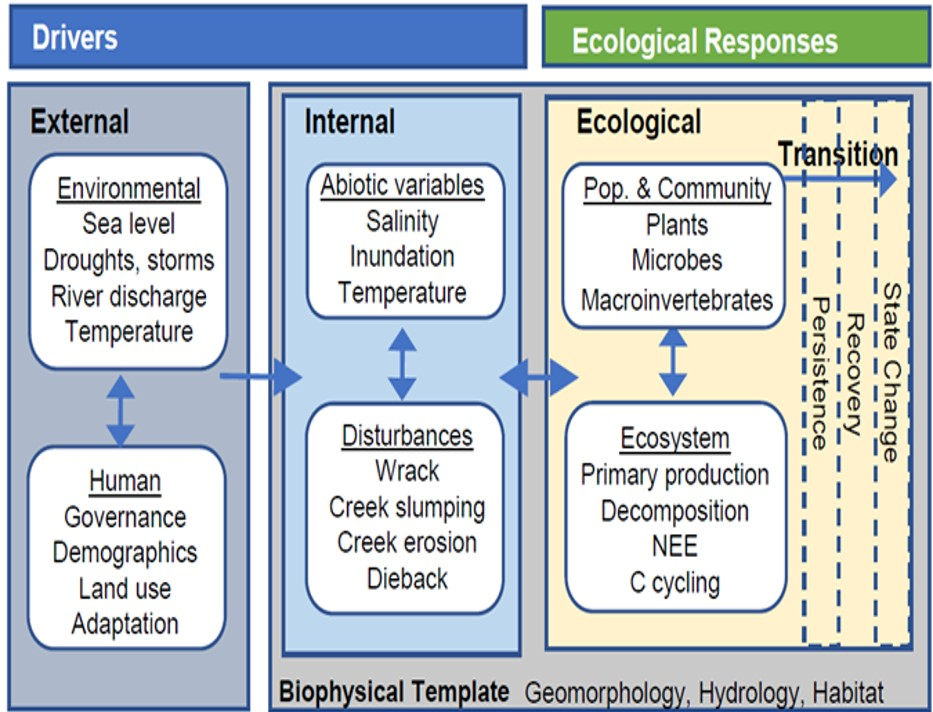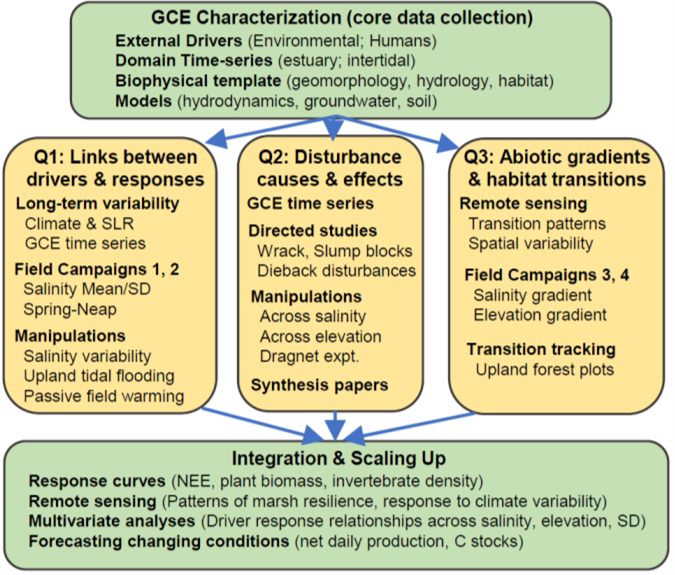GCE Research Program
Program Overview
The overall goal of the GCE-LTER is to understand estuarine and intertidal ecosystems and how they respond to long-term change. Over the past four funding cycles we have established a robust program of long-term field observations, experiments, remote sensing, and modeling to produce fundamental insights into coastal wetland ecosystem function. As we have deepened our knowledge of these systems we have added research explicitly focused on habitat transitions and the role of disturbance in structuring wetland landscapes. These efforts represent the ongoing core of our program and are essential for identifying the nature and mechanisms of long-term ecological change. In GCE-V, we are building on this foundation to determine 1) whether our understanding of the system can be improved by assessing driver variability in predicting ecological responses and 2) the potential value of ecological variability as a fundamental metric of system behavior. This conceptual framework, which applies well beyond wetland ecosystems, provides the motivation for the new research described below.
GCE-IV Focus Areas
The research activities in GCE-IV are designed to characterize perturbation patterns and their relationships to external drivers, to develop an understanding of disturbance responses to perturbations, and to evaluate the consequences of these responses at the landscape scale.
We divide our research into four inter-related programmatic areas:
External drivers of change (Area 1): We characterize external drivers such as climate change, sea-level rise, and human alterations of the landscape in terms of long-term trends, spatio-temporal variability, and occurrence of extreme events (e.g., storms, droughts) so that we can investigate the links between external drivers and ecosystem response. (more information)
Long-term patterns of estuary and intertidal variation (Area 2): We track the temporal and spatial variability of the habitats within the GCE study area through a combination of field monitoring and remote sensing in order to evaluate ecosystem responses to long-term change and domain perturbations. (more information)
Process studies (Area 3): We conduct long-term manipulations as well as focused investigations designed to develop a mechanistic understanding of ecosystem function and responses to both long-term and episodic changes. (more information)
Integration and scaling up (Area 4): We use a combination of remote sensing, field investigations, and modeling to document and evaluate the consequences of long-term change and disturbance at the landscape scale. (more information)
Conceptual Model Guiding GCE Research

GCE-IV Research Portfolio

GCE-V Focus Areas
The research activities in GCE-V are designed to understand wetland ecosystem function, the connections between external drivers and ecological responses, and how ecological properties change in response to disturbance and underlying abiotic gradients, but with an overlay of new efforts that test the above hypotheses regarding the role of variability.
We divide our research into five inter-related programmatic areas:
GCE characterization. What are the spatial and temporal patterns in drivers and responses? We continue to characterize spatial and temporal patterns in mean and variability of drivers and responses. This will be done by measuring external drivers (e.g., sea level), marsh and estuarine conditions, the wetland biophysical template, and modeling.
Q1. What are the linkages between external drivers and ecological responses, and does assessing the variability of key abiotic drivers improve explanatory power for predicting ecological responses? We evaluate linkages between external drivers and ecological responses, and determine whether assessing the variability of abiotic drivers improves explanatory power for predicting those responses. This will be done by analyzing long-term data and conducting field campaigns in areas with different salinity standard deviations and time-varying inundation, and complementary mechanistic experiments exploring effects of driver variability (e.g., salinity).
Q2. What are the causes and consequences of disturbances in the system, and how do they affect patterns of variability in ecological responses? We assess disturbances and their effects on patterns of variability in ecological responses. This will be done by tracking response to and recovery from natural disturbances in the field and in ongoing experimental manipulations.
Q3. How do ecological properties change across abiotic gradients, and does variability increase near habitat transitions? We evaluate how ecological properties change across abiotic gradients, and determine whether variability increases near habitat transitions. This will be done using remote sensing, sampling across gradients of salinity and inundation, and establishing new long-term monitoring sites in forested areas to track upland marsh migration.
Integration and Scaling Up. What are the mechanisms by which coastal wetlands respond to changing drivers, and does variability in drivers and responses inform this understanding? We will determine the mechanisms by which coastal wetlands respond to changing drivers and assess whether variability informs this understanding. This will be done by conducting univariate and multivariate analyses relating key ecosystem variables (e.g., net ecosystem exchange, plant biomass) to drivers (salinity, inundation, temperature), using remote sensing to investigate spatial and temporal patterns in the mean and variability of marsh productivity and their relationship to variability in climate drivers, and synthesizing results to describe net daytime production and above- and below-ground C stocks and how they might change in response to future conditions.
Conceptual Model Guiding GCE Research

GCE-IV Research Portfolio

Signature Publications


